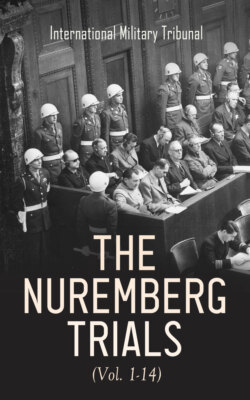Читать книгу The Nuremberg Trials (Vol. 1-14) - International Military Tribunal - Страница 99
ОглавлениеPulse: Rate 100, rhythm irregular. The irregularity was due to extra-systoles. The radial arteries were just palpable, without evidence of pathological thickening or tortuosity. Blood pressure: systolic 130 mm. of mercury, diastolic 80 mm. of mercury.
Heart: The heart was clinically not enlarged. The cardiac sounds were feeble, there was no accentuation of the second sound in the aortic area, nor were any cardiac murmurs audible. There were no vascular changes observable in the vessels of the fundi. There was no evidence of cedema or of congestive heart failure.
5. Respiratory Examination: Chest movement satisfactory. There was no impairment of percussion noted. Auscultation revealed no impairment of air entry, no alteration in the breath sounds, and the absence of any adventitious sounds.
6. Alimentary-renal Examination: There was slight distention of the abdomen, due to increase in the gaseous content of the intestines. There was no evidence of ascites. The spleen was not palpable, nor was there any evidence of glandular enlargement. The liver was just palpable, one finger’s breadth below the right costal margin, but there was no evidence of enlargement upwards. Urinalysis: no sugar or albumen present.
7. Skeletal Examination: The patient’s rigidity limited the examination of joints. There was limitation of movement of the neck due to muscular hypertonus. The hypertonus was so marked in the lower dorsal and lumbar region as to produce rigidity of the spine. Attempts to move the joints passively stimulated involuntary contractures of the muscles. There was evidence of crepitus in both knee-joints.
DISCUSSION:
The clinical record presented by this patient is that of an organic cerebral disorder, with predominant involvement of the frontal lobes and basal ganglia. The mental disintegration of the patient renders him incapable of comprehending his environment, and of reacting normally to it. He remains uniformly apathetic and disinterested, intellectually retarded to a very marked degree, and shows no evidence of spontaneous activity.
The above findings are such as are found in the degenerative changes associated with senility. The findings in the visceral organs are likewise compatible with the diagnosis of senile degeneration.
The clinical course, from the evidence obtained, has been that of a gradual decline over a period of years, with more rapid deterioration during the past year. Such deterioration will continue, and would be rapidly accelerated, with immediate danger to the patient’s life, were he to be moved from his present location.
DIAGNOSIS:
Senile degeneration of the brain tissues, selectively affecting the frontal lobes of the cerebral cortex and the basal ganglia, with associated senile degeneration of the visceral organs.
| /s/ | R. E. TUNBRIDGE | |
| Brigadier, O.B.E., M.D., M.Sc., F.R.C.P., Consulting Physician, British Army of the Rhine | ||
| /s/ | RENE PIEDELIEVRE | |
| M.D., Professor of the Paris Faculty of Medicine, Expert of the Tribunal | ||
| /s/ | NICOLAS KURSHAKOV | |
| M.D., Professor of Medicine, Medical Institute of Moscow, Chief Internist, Commissariat of Public Health U.S.S.R. | ||
| /s/ | EUGENE SEPP | |
| M.D., Emeritus Professor of Neurology, Medical Inst, of Moscow; Member, Academy of Medical Sciences, U.S.S.R. | ||
| /s/ | EUGENE KRASNUSHKIN | |
| M.D., Professor of Psychiatry, Medical Institute of Moscow. | ||
| /s/ | BERTRAM SCHAFFNER | |
| Major, Medical Corps, Neuropsychiatrist, Army of the United States |
